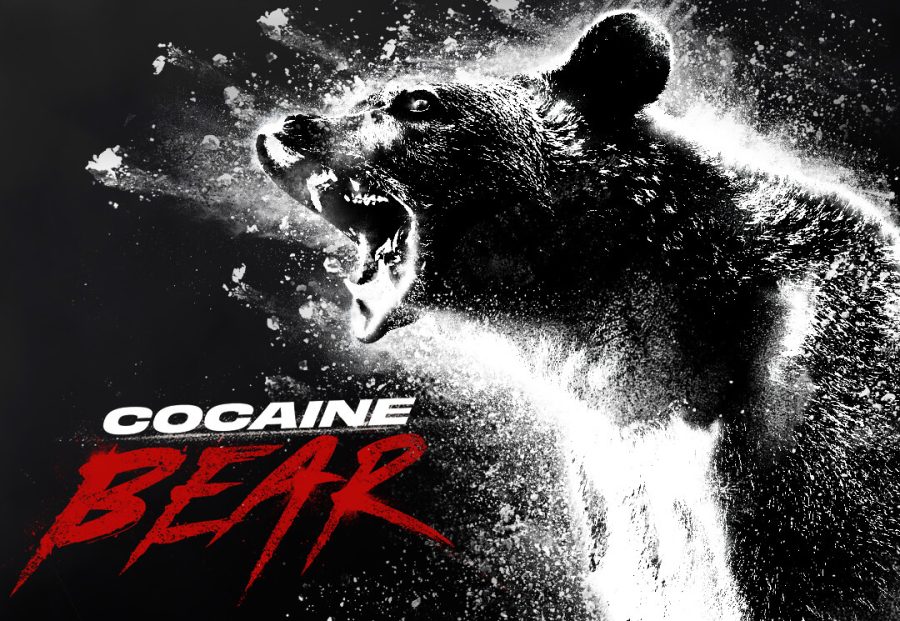Lee: ‘Cocaine Bear’ underwhelms a hoped-for high
Universal Pictures’ latest film release, “Cocaine Bear,” dramatizes the tragic story of real-life American black bear who died from cocaine overdose. In the murder thriller, the bear finds bags filled of the drug and indulges itself to a 75-pound cocaine high.
March 24, 2023
Perhaps the single greatest achievement “Cocaine Bear” possesses is, simply, its existence.
If one traveled back in time and pitched a similar film to executives only a couple of decades ago, they would likely have been laughed out of the drawing room. Now in 2023 — a raunchier, more boisterous era of cinema — the whimsical concept secured a budget of over $30 million from Universal Pictures.
This optimistic funding has not been an entirely baseless investment either, with the movie more than doubling the studio’s initial expenditure.
Despite its commercial success, “Cocaine Bear” is an absolute mess of a film, overusing exaggerated shock-factor techniques and avoiding any sort of real purpose in favor of mindless entertainment.
The film’s concept is perhaps the most engaging aspect of it. In case it was hard to infer from the title, “Cocaine Bear” follows an aircraft-drug-drop-gone-wrong in the forests of the Chattahoochee-Oconee National Park. Dozens of bags of cocaine are scattered across the park, sparking multiple unrelated parties — including a detective, two drug dealers and a group of teenage delinquents — to scour the forest in search of them. Their issue? A local CGI black bear tore into a couple of the bags and consumed the cocaine, turning its normal animalistic instincts into an uncontrolled and insensible blood thirst.
Although this screenplay is supposedly adapted from a true story, this is an incredibly misleading statement. The true story, which occurred in 1985, is far less interesting. There actually was a real “Cocaine Bear,” but the 175-pound animal died shortly after consuming a duffel bag filled with the powdery drug. There was no killing spree, no drug search and no thrilling event: only the sad death of a bear that would be sensationalized for audiences four decades later.
So, in a way, the film aims to reimagine the historical event as an anecdote actually worth making a movie about. What if the bear hadn’t just died from the overdose, but had a human-like high?
Unfortunately, “Cocaine Bear” fails to use this interesting concept in any interesting way.
The scene-to-scene progression of the film is awful. Primarily, the story takes place over a variety of separate plotlines, only converging in a slightly meaningful way near the end. This story structure can work wonders if done right, but in “Cocaine Bear,” the purpose and motivations of each character are loosely defined, leaving a confusing viewing experience no matter the specific storyline.
In the expository stage of the film, before any massacres have occurred, the film is tremendously muddled. The film jumps between segments at break-neck speed, not giving the audience any time to sympathize — or even marginally grasp — any of the scenes happening before them. Single mother Sari (Keri Russell) searches the national park for her 13-year-old daughter and her daughter’s friend, who have randomly skipped school to sketch a picture of a nondescript waterfall in the middle of the woods. Drug kingpin Syd (Ray Liotta in his last-ever film appearance) sends his son Eddie (Ayden Ehrenreich) and right-hand man Daveed (O’Shea Jackson Jr.) to retrieve the lost cocaine assets. Park rangers Liz (Margot Martindale) and Peter (Jesse Tyler Ferguson) shoo away a group of no-good teenage delinquents and help Sari search for the children.
There are other — more isolated — storylines, too, but they end early in the film’s runtime, being only brief, farcical episodes of unimportance.
Though, as the plot unfolds it becomes more obvious these expository scenes are but steppingstones to the film’s main attraction: graphic, grisly gore. This gore, while giving the film more action and making it more flatly engaging, fails to add any worthwhile voice to the story. This is completely fine — not every film needs to be posing existential questions to its viewers. However, “Cocaine Bear” strays so intentionally away from anything of importance that its purpose feels like it is, similarly to the film’s titular substance, to briefly enthrall audiences and help them forget the pressing forces of reality.
The film, according to IMDB, is categorized as a comedy/thriller. While somewhat competent as a flat, shocking thriller, “Cocaine Bear” falls woefully short of a comedy. The humor feels improvisational, which isn’t necessarily a bad quality, but the overextension of certain gags makes the comedy, at times, feel like a bloated Saturday Night Live skit. A bear on cocaine is certainly a humorous thought, but the film — throughout its entire runtime — relies too heavily on the silly novelty of this concept, neglecting to bolster it with, you know, actual humor.
The film wants so badly to be a cultural phenomenon, with the Cocaine Bear even making an awkward, forced appearance at the recent Oscars. However, the truth is “Cocaine Bear” is a menial, poorly written gore-fest sensationalized for excitement, and its longtime influence will never attain a status more than an attention-grabbing title.









